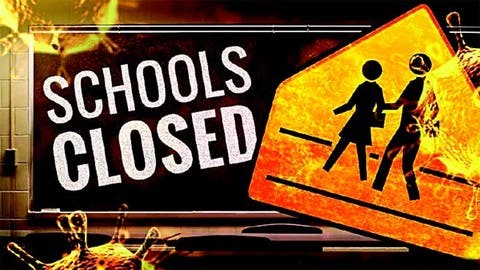COVID-019: FG releases guidelines as it begins plans for schools’ resumption

•Recommends distance learning, satellite centres, online teachings, learning, others
•To fumigate schools, restructure classes in line with social distancing guideline
•Train teachers on hygiene, other safety measures
THE Federal Government, Monday, released guidelines ahead of the resumption of schools at every level in the country, but it failed to disclose when schools will resume.
The guidelines for the safe reopening of schools and learning facilities after the COVID-19 pandemic outlined actions, measures, and requirements needed for the safe reopening of schools.
The safe distancing measures in the new guidelines require that in schools and other learning facilities, learners should be supported to stay two meters apart.
“However, there are exceptions where the two-meter rule cannot be reasonably applied and other risk mitigation strategies may be adopted. Examples include early years, younger primary school children, and those with additional needs,” the document read.
It added: “In these circumstances, risk assessments must be undertaken with the best interests of the learners, teachers, and other education personnel in mind.
“The scenarios require organising learners and children into small groups with consistent membership and compliance with the risk mitigation strategies. The membership of these groups should not change unless the NCDC public health guideline suggests otherwise.”
With the release of the document, the government will conduct a rapid assessment and determine the funding requirement for upgrading infrastructure and facilities (such as classrooms, furniture, WASH, and ICT facilities) to meet and sustain prescribed safe school reopening requirements.
The Federal Ministry of Education, in the guidelines it developed in collaboration with the Federal Ministry of Environment, the Federal Ministry of Health and health safety experts, said it was time for it to plan and address the eventual safe reopening of schools and learning facilities.
It will be recalled that at the outbreak of the COVID-19 pandemic in Nigeria, schools and all learning facilities were closed in order to safeguard the health and general wellbeing of children, youths, teachers, and educational personnel.
Notable among the items in the guidelines are recommendations for the review of existing policies, practices, and risk mitigation strategies in the use of schools for other purposes, such as distance learning centres, temporary shelters, isolation, quarantine and treatment centres, markets, voting centres, among others.
The government, while noting that, “COVID-19 pandemic poses an enormous risk to the health and safety of learners, teachers, parents, school administrators, education practitioners, and the wider community”, regretted that, “More than 1.5 billion children and young people globally have been affected by school and university closures.
“As a responsible government, it is also our duty to provide comprehensive guidelines for a safe and hitch-free reopening of schools and learning facilities. We do so knowing that the health, safety, and security of learners,
teachers, education personnel, and families are priorities,” the government said in a guideline signed by the Ministers of Education, Mallam Adamu Adamu and Hon Chukwuemeka Nwajiuba.
The guidelines dealt extensively on equitable plans for school reopening and operations.
The document focuses on attendance, social distancing, hygiene, cleaning, and non-pharmaceutical interventions for safe and healthy school activities and programmes.
Minister of Education, Adamu Adamu, explained that the need to develop the guidelines became imperative, “Given that COVID-19 may be with us for a while.”
He said the guidelines also highlight the urgent need to maintain and improve upon distance-learning programmes.
“Our aim is to identify and strengthen programmes that will guarantee the recovery of learning gaps resulting from the pandemic,” Adamu said, adding that “The guidelines were drafted in close coordination with health, environmental, education, and school safety experts who were tasked with the responsibility of charting a pathway for safely reopening our schools and learning facilities for quality teaching and learning.”
The approach, according to him, ensured that stakeholders provided regular feedback throughout the process.
“The Federal Ministry of Education expresses gratitude to the Presidential Taskforce on COVID-19, the Federal Ministry of Health, Nigeria Centre for Disease Control (NCDC), and the Education in Emergencies
Working Group in Nigeria (EiEWGN) for their support and contribution to the development of the guidelines.”
While noting that, “Collaboration and partnerships are also a key focus of this document”, Adamu “thank the various stakeholders who have pledged their support and assistance toward the implementation of the guidelines.”
The goal of the guideline, the government explained, was “to support and facilitate prompt and safe achievement of the objectives of the Nigeria Education Sector COVID-19 Response Strategy.
“The guidelines will assist federal, state, and local governments and their relevant ministries, departments, and agencies (MDAs), families, communities, and authorities in decision-making, approach modelling, and operational planning for safely reopening schools, recovering pre-pandemic capacities, and institutionalising good safe school practices for the transformation of the education sector in the long term,” it further explained.
It added: “The availability of these guidelines and implementation of its recommendations will ensure that all stakeholders within the educational system have a sense of their rights and responsibilities. In addition, this will help learners, teachers, parents, guardians, communities, and the larger society to trust the process of reopening and be assured that learning will continue in a safe and protective environment.
“This will also support governments in education reforms and effective service delivery during and post COVID-19 pandemic in Nigeria,” it stressed.
The guidelines, according to the government, was in: “Ensuring adequate preparedness of schools and learning facilities for reopening and resumption of academic and other ancillary activities without placing the health, safety, and security of learners, teachers, administrators, and other education personnel at risk.”
The document recommended what government called,” systematic, phased, safe reopening that factors resource availability to meet basic requirements and differentials in COVID-19 effect (e.g fumigation and disinfection of schools; provision of learning material; impact and vulnerabilities across schools, learning facilities, communities, localities, local governments, and states).”
Its action, it explained, was aimed at “Continued safe and quality teaching and learning activities by learners,
teachers, and administrators that meet prescribed standards through remote and e-learning platforms with adequate safeguarding of their health, safety, and security during the school shutdown period.”
Others are “Entrenching and institutionalizing good practices in health, safety, and security in the nation’s education sector in the long term to strengthen the system.”
Principles that should guide decisions, preparations, and actions of the federal, state, and local governments, non-state education providers, communities and other relevant stakeholders to close, partially close, or reopen schools, according to the guidelines, include: “Consultation with school administrators, teachers, parents, parent-teacher associations (PTAs), school-based management committees (SBMCs), communities, development partners, civil society, and the private sector in the decision-making process.”
The safety and hygiene measures outlined in this document should, as in all cases, be followed carefully, “the government said, adding “It is imperative that safe distancing between adult staff working with such groups be maintained.”
While considering what it called “Alternative learning models for safe distancing,” the government said: “As schools and learning facilities reopen, they must implement safe distancing measures that minimize and isolate risk. As such, they may offer some alternative learning models.”
On outdoor learning, the document read: “This can limit transmission and also allows for safe distancing between learners and teachers. The use of shelter outdoors is necessary for the protection and safety of learners and teachers. In addition, safety in all weathers and security measures are required for each location.”
On staggered attendance, it said: “Learners may arrive and depart at different times to avoid overcrowding; schools may reopen gradually (e.g., starting with particular grade levels).”
On alternate attendance, the government said: “Schools may alternate attendance days per week, with learners at the secondary level (or equivalent) and above having fewer in-person classes, since these learners can better manage independent learning (e.g. junior secondary school learners attend on Tuesdays and Thursdays while primary school learners attend classes on Mondays, Wednesdays, and Fridays).”
While also considering platooning, it said: “Classes may be divided into morning and afternoon shifts.”
On decreased interaction, it said: “Learners may remain in one location with teachers coming to them.
On closing and reopening, the document read: “Federal and SMoE must consider the following when deciding on whether to close, partially close, or reopen schools and other learning facilities:
“A gradual and phased reopening can then be considered while prioritising learners who are vulnerable, have reduced access to distance learning modalities, and/or are in examination classes.
“This would help assess the readiness of schools and learning facilities to reopen fully to all learners. In addition, this would serve to minimize the risk of a resurgence of coronavirus infections.
“The following steps and actions should be taken before schools and learning facilities are reopened to safeguard the health and ensure safety and security of learners, teachers, administrators, and other education personnel,” it warned.
The guidelines sought: “Sustained campaigns, advocacy and sensitization, especially in rural and remote areas and child/ girl-friendly messaging (using animations, infographics and cartoons in local languages) on the pandemic and public health and safety measures to be adopted to promote necessary behavioural change.”
On safety hygiene, the guidelines read: “Disinfection and fumigation of facilities, including hostel accommodation; particular attention is given to those used as temporary isolation and treatment centres and for other purposes during the pandemic.
“Ensure a School COVID-19 Referral System, including protocols and procedures to take if learners, teachers, administrators, and other education personnel become unwell while in schools Develop detailed protocols and provide facilities and measures for the maintenance of two-meter safe distancing to comply with NCDC guideline
“Develop detailed protocols and provide facilities to establish and maintain prescribed hygiene standards and practices, including WASH, hand washing, access to adequate gender-segregated toilet facilities, cross-ventilation of classrooms and hostel accommodation, use of face masks, proper food preparation and
handling as well as disposal of wastes Sensitize, train, and build the capacity of teachers, administrators, and other education personnel to effectively use and comply with the School COVID-19 Referral System and protocols for safe distancing and hygiene in schools Set up school hygiene committees with designated hygiene champion to monitor and promote compliance.”
The government promised that it would, “Mobilise and deploy new and existing resources to recruit additional teachers and education personnel to guarantee prescribed safe distancing teacher-learner ratio; Equip and resource schools for improved teaching and learning methods for special needs learners Provide WASH facilities including soap, hand sanitizers, and girls’ dignity kits in schools.”
It also said it would: “Establish and adequately equip dispensaries and clinics as appropriate Create adequate classrooms and learning spaces to maintain safe distancing in schools; Provide better-ventilated classrooms and TLCs-use solar power and alternative energy sources for electricity, and boreholes for water.”
Reopening process
When it has been demonstrated that it is safe for teachers and learners to go back to school, a phased and gradual reopening of schools is advocated to minimize the risk of infections in schools and resurgence of coronavirus infections in the community.
Dwelling on Safety hygiene, the government said it will, “Train teachers, administrators, and other education personnel on safety and hygiene measures—disinfection, safe distancing, hand washing, use of masks, respiratory etiquette, waste management Ensure availability of adequate WASH facilities, including potable water, soap, sanitizers, and handwashing points at all times.”
The guidelines tasked schools to: “Display IEC materials on hygiene education around the premises and in classrooms; Ensure the establishment of a School COVID-19 Referral System (including protocols and procedures to take if learners, teachers, administrators, and other education personnel become unwell while in school); Create immediate temporary isolation space; Maintain regular contact and collaborate with health authorities on school safety, health, and hygiene.”
Others, it said were to: “Develop appropriate mental health and psychosocial support services that address stigmatization and discrimination to assist learners, teachers, administrators, and other education personnel
and their families to cope with the effects of COVID-19 and continued uncertainties of the pandemic; Make adequate provisions for school feeding where applicable to encourage learners to return and sustain attendance.” (Vanguard)

